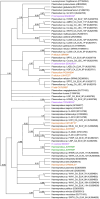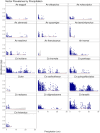Haemosporidian Infection Risk Variation Across an Urban Gradient in a Songbird
- PMID: 40641488
- PMCID: PMC12240680
- DOI: 10.1002/ece3.71770
Haemosporidian Infection Risk Variation Across an Urban Gradient in a Songbird
Abstract
Urbanization is a significant source of inter- and intra-city environmental variation and is associated with declining avian population sizes, with a shift towards more homogeneous communities that consist of large populations of the same species. However, whether this shift extends to urban disease ecology and related parasite communities requires further examination. By comparing the diversity of two related parasite genera (largely host-generalist Plasmodium and largely host-specialist Haemoproteus) and infection status of dark-eyed juncos (Junco hyemalis) across an urbanization gradient in California, we can determine how broad urban-associated land use changes and localized habitat composition correlate with pathogen communities. Additionally, by examining vector abundance responses, we can begin to assess broader impacts on urban disease transmission and ecology. We report fewer birds were infected with Haemoproteus in urban habitats, with a larger presence of host-generalist lineages, suggesting urbanization increases homogenization of host-specialist pathogens. Unsurprisingly, the largely host-generalist pathogen, Plasmodium, showed no correlation with urbanization, but infections increased with rainfall. Local habitat characteristics had limited effects on Plasmodium infection status, but biotic characteristics, including wing chord length and human presence, were associated with Plasmodium infections. Lastly, Culex tarsalis, an important vector for Plasmodium and zoonotic pathogens, was the only vector to also increase in abundance in response to rainfall. Our results show that broad land use changes associated with urbanization decrease avian parasite biodiversity and highlight localized abiotic and biotic habitat characteristics that may reduce infection prevalence.
Keywords: avian infectious disease ecology; dark‐eyed juncos; urban ecology; vector ecology.
© 2025 The Author(s). Ecology and Evolution published by British Ecological Society and John Wiley & Sons Ltd.
Conflict of interest statement
The authors declare no conflicts of interest.
Figures










References
-
- Abella‐Medrano, C. A. , Ibáñez‐Bernal S., Carbó‐Ramírez P., and Santiago‐Alarcon D.. 2018. “Blood‐Meal Preferences and Avian Malaria Detection in Mosquitoes (Diptera: Culicidae) Captured at Different Land Use Types Within a Neotropical Montane Cloud Forest Matrix.” Parasitology International 67: 313–320. - PubMed
-
- Anderson, D. R. , and Burnham K. P.. 2002. “Avoiding Pitfalls When Using Information‐Theoretic Methods.” Journal of Wildlife Management 66: 912.
Associated data
LinkOut - more resources
Full Text Sources

